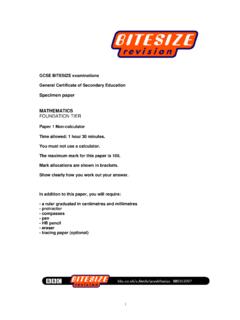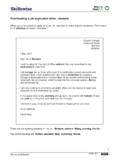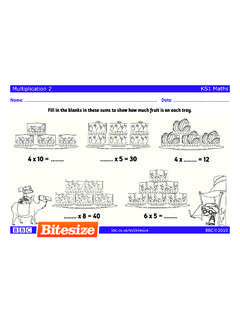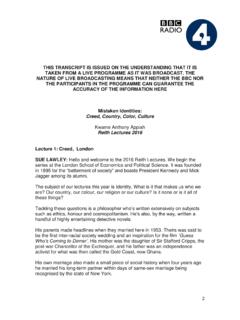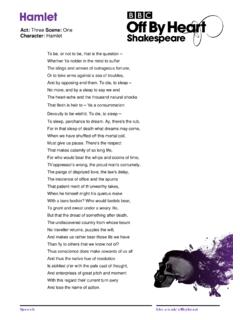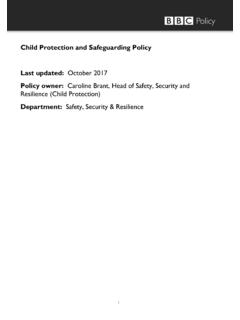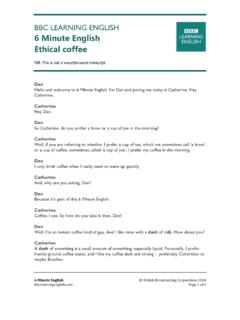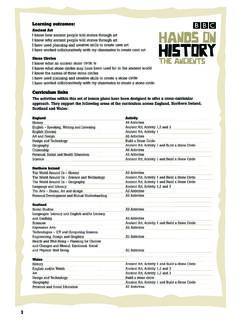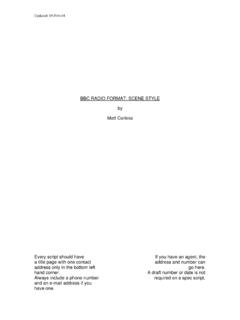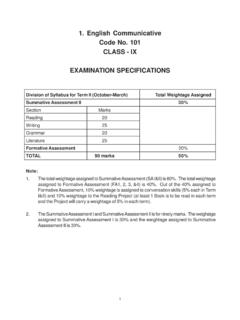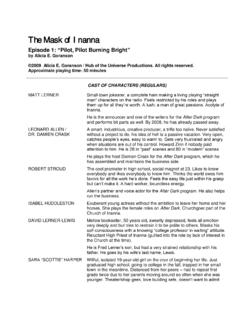Transcription of RADIO DRAMA FORMAT - BBC
1 Every script should have If you have an agent a title page with one contact the address and number address only in the bottom can go here. left hand corner. A draft number or date Always include a phone number is not required on a and an e-mail address if you spec script. have one. RADIO DRAMA FORMAT Written by Matt Carless RADIO DRAMA FORMAT 1. Scene One: Int. Location #1 - Day 1. MUSIC: ALL CUES ARE NUMBERED. SOUND AND MUSIC APPEAR IN ALL CAPITALS UNDERLINED. 2. CHARACTER #1: Character names appear in all capitals. A character is designated by either their first or last name, but a role designation may be used instead. The designated character name should remain consistent throughout the script. 3. SOUND: ALL SOUND EFFECTS SHOULD BE USED SPARINGLY AND WORK WITH THE DIALOGUE. 4. CHARACTER #2: Dialogue begins on the same line as the character name in normal upper and lower-case text with double-spacing.
2 5. SOUND: IF A SOUND OR MUSIC CUE INTERRUPTS A CHARACTER'S SPEECH ON THE SAME 6. Then continue the dialogue without repeating the character name. 7. CHARACTER #1: Split dialogue between pages only if at least two lines appear on the first page, and only after a sentence. CHARA #1/CONT'D RADIO DRAMA FORMAT 2. 1. CHARA #1 (CONT'D): Begin the following page with a new cue. The only means of establishing a character's presence is to have them speak or be referred to by name. If there are too many characters in a scene, the listener will lose track. 2. MUSIC: BRIDGE. Scene Two: Int. Location #2 - Night 3. SOUND: SCENE HEADINGS ARE NOT NECESSARY BUT CAN BE USED. 4. CHARACTER #1: (BEAT) Parenthetical instructions appear in capitals enclosed within round brackets in the body of the dialogue. (PAUSE) It is recommended that these are used sparingly!
3 5. SOUND: THERE ARE A NUMBER OF COMMON TERMS USED FOR TELESCOPING DIALOGUE. 6. CHARACTER #2: (OFF MIKE) Indicates that the actor should speak away from the microphone. The audio equivalent of "off-screen". 7. CHARACTER #1: (VOICEOVER) Indicates a character who is narrating over sound, music or dialogue. RADIO DRAMA FORMAT 3. 1. CHARACTER #2: (FILTER) Indicates a character who is speaking via a mechanical device like a telephone or RADIO . 2. CHARACTER #1: (HOT ON MIKE) Indicates that the actor should be very close to the microphone giving an intimate feel to the dialogue. 3. CHARACTER #2: (TOP) Indicates that the actor should begin their line before the previous speaker has finished and at a louder volume. Scene Three: Int. Location #1 - Day 4. SOUND: DON'T FORGET TO NUMBER ALL OF YOUR PAGES - PAGE ONE BEGINS WITH SCENE ONE, NOT THE TITLE PAGE.
4 5. CHARACTER #1: And secure your pages with a simple paper binder or brass brad. Unfastened pages can become separated from the rest of the script and get lost. 6. CHARACTER #2: It is customary to sign-off a RADIO script in the following way. THE END


